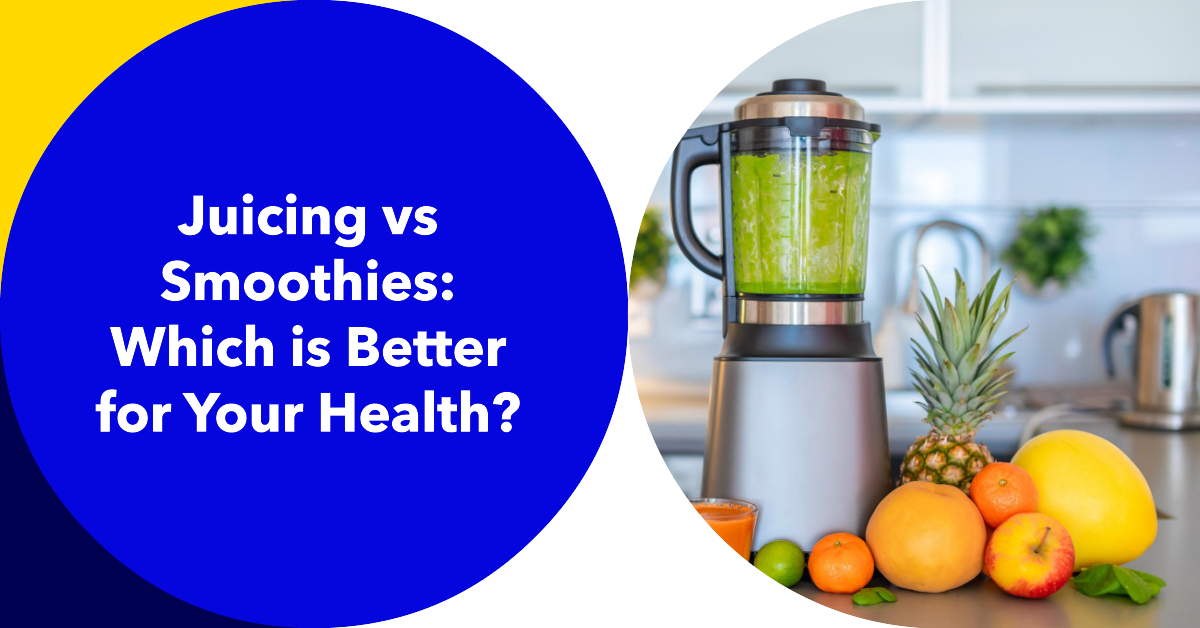Greetings! We’re thrilled to share an insightful comparison of juicing and smoothies with you. As you may know, these two methods have gained immense popularity in the health industry for their incredible ability to deliver vital vitamins and minerals from fruits and veggies.
Both options offer an effortless way to consume a wide range of nutrients in just one drink. Our latest blog post takes an in-depth look at each approach’s unique benefits and potential drawbacks, empowering you to make an informed decision that aligns with your personal health goals. We’re confident that this information will be helpful and inspiring!
The Ultimate Juicing vs Smoothie Comparison: All You Need to Know
To help you understand the key distinctions and benefits of juicing and smoothies, we will first talk about juicing and then discuss smoothies.
Furthermore, we will also guide you in choosing the best one for you. Let’s start.
Part 1: Juicing Explained
I. What is Juicing?
Juicing involves extracting the liquid from fruits and vegetables, leaving behind the fibrous pulp. By removing the pulp, juicing concentrates the vitamins, minerals, and antioxidants in the produce, making them easier for your body to absorb.
II. Nutritional Benefits of Juicing
Juicing can be an excellent way to increase your nutrient intake, especially if you struggle to consume adequate fruits and vegetables daily. The concentrated nutrients in juices can immediately boost your immune system and overall health.
a. High nutrient concentration:
Fruits and vegetables are rich sources of essential vitamins and minerals. Juicing allows you to consume more of these nutrients in a single glass than you might otherwise eat whole.
b. Increased vegetable intake:
Many people find it challenging to consume enough vegetables throughout the day. Juicing offers a convenient solution, as you can combine various vegetables into a single juice serving, ensuring you get a broad range of nutrients.
c. Boosts hydration:
Proper hydration is crucial for optimal health. Juices provide a refreshing and hydrating way to consume essential nutrients, especially during hot weather or after physical activity.
III. Potential Drawbacks of Juicing
While juicing can be a beneficial addition to your diet, it’s essential to be aware of potential downsides.
a. Lack of fiber:
Removing the fiber during the juicing process eliminates an essential component of whole fruits and vegetables. Fiber aids digestion promotes satiety, and helps regulate blood sugar levels. Juices might not keep you feeling full without fiber as long as whole fruits and vegetables would.
b. Calorie and sugar content:
While the vitamins and minerals in juices are beneficial, some fruits and vegetables are naturally high in sugars and calories. Consuming excessive amounts of sugary juices could lead to weight gain or blood sugar spikes, especially for individuals with diabetes or those trying to manage their weight.
Part 2: Smoothies Explained
I. What are Smoothies?
Smoothies involve blending whole fruits and vegetables, retaining their fiber content. Unlike juicing, where the pulp is removed, smoothies utilize the entire fruit or vegetable, making them thicker and more filling.
II. Nutritional Benefits of Smoothies
Smoothies can be a fantastic way to ensure you receive a complete nutritional package, including essential vitamins, minerals, and fiber.
a. Fiber-rich:
Fiber is vital in promoting healthy digestion and can help prevent constipation. Smoothies retain the fiber from fruits and vegetables, which aids in regulating bowel movements and keeping your gut healthy.
b. Complete nutrition:
Smoothies offer an opportunity to incorporate a balanced combination of macronutrients (carbohydrates, proteins, and fats) and micronutrients (vitamins and minerals) into your diet. You can add ingredients such as Greek yogurt, nut butter, or seeds to boost your smoothies’ protein and healthy fat content.
c. Sustained energy:
The presence of fiber and a balance of nutrients in smoothies can provide a steady release of energy throughout the day, making them an excellent choice for breakfast or as a snack between meals.
III. Potential Drawbacks of Smoothies
While smoothies have numerous health benefits, it’s essential to be mindful of certain factors.
a. Overconsumption of calories:
Smoothies can become high in calories when loaded with sugary fruits, sweeteners, or excessive fats. If you’re not careful with portion sizes or ingredients, you might unknowingly consume more calories than you need, hindering weight management efforts.
b. Picky eaters:
Some people may find it challenging to incorporate certain vegetables or textures into their smoothies. However, with the right combination of ingredients and a little experimentation, you can create delicious and nutritious smoothies that suit your taste preferences.
Choosing What’s Best for You: Juicing vs Smoothie
1. Health Goals and Dietary Preferences
When deciding between juicing and smoothies, consider your health goals and dietary preferences.
a. Weight loss:
If weight loss is your primary goal, smoothies might be more suitable due to their fiber content, which promotes satiety and reduces the likelihood of overeating.
b. Detoxification:
Juicing might be preferred for a short-term cleanse or detox due to its concentrated nutrient profile. However, it’s essential to remember that the body has its natural detoxification processes, and prolonged juice cleanses are not recommended without proper medical supervision.
c. Athletic performance:
Athletes or individuals with active lifestyles may benefit from smoothies with added protein sources like Greek yogurt, protein powder, or nut butter to aid muscle recovery and repair.
2. Balanced Approach
Consider incorporating both into your dietary routine instead of viewing juicing and smoothies as competing methods.
a. Enjoy the best of both worlds:
By including juices and smoothies in your diet, you can take advantage of each method’s unique benefits. Start your day with a nutrient-packed smoothie and enjoy fresh juice as a mid-day pick-me-up.
b. Opt for low-sugar options:
To make your juices and smoothies healthier, choose low-sugar fruits and vegetables and avoid adding extra sweeteners. Experiment with herbs and spices like ginger or mint to enhance the flavor without adding sugars.
Five Tips for Making Healthy Juices and Smoothies
a. Use a variety of fruits and vegetables:
Use a diverse selection of colorful produce in your juices and smoothies to maximize the nutritional benefits. Different fruits and vegetables contain unique vitamins, minerals, and antioxidants.
b. Don’t skimp on greens:
Leafy greens, such as spinach, kale, or Swiss chard, are excellent additions to juices and smoothies. They are packed with vitamins and minerals, adding a vibrant green color to your concoctions.
c. Incorporate healthy fats and proteins:
To make your smoothies more filling and nutritionally balanced, add sources of healthy fats like avocados, chia seeds, or flaxseeds. Consider using Greek yogurt, nut butter, or a scoop of protein powder for extra protein.
d. Hydration base:
When blending smoothies, use a liquid base like water, coconut water, almond milk, or coconut milk. This ensures a smooth consistency while providing additional hydration.
e. Mind your portions:
Pay attention to portion sizes, especially if you are watching your calorie intake. Use smaller glasses or cups to control your portion sizes and prevent excessive calorie consumption.
Final Words:
There’s no definitive winner in the juicing vs. smoothies debate—both methods offer unique advantages. Juicing provides a concentrated nutrient boost, while smoothies offer fiber and sustained energy. The key is to make informed choices based on your health goals, dietary preferences, and lifestyle.
A balanced approach that incorporates juicing and smoothies can be an excellent way to maximize your nutrient intake and support overall well-being. Remember to use fresh, high-quality ingredients, and get creative with your recipes. Cheers to a healthier, more nourished you!

